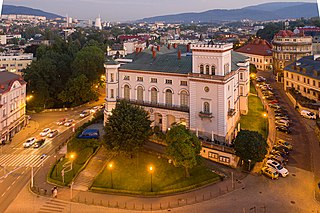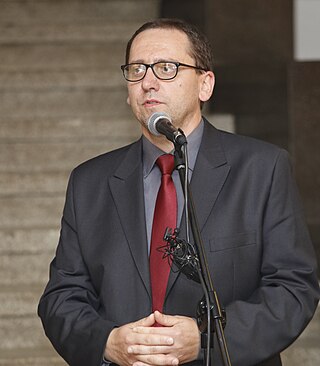
Bielsko-Biała is a city in southern Poland, with a population of approximately 166,765 as of December 2022, making it the 22nd largest city in Poland, and an area of 124.51 km2 (48.07 sq mi). It is the core of the broader metropolitan area with around 335,000 inhabitants. It serves as the seat of the Bielsko County, Euroregion Beskydy, Roman Catholic Diocese of Bielsko–Żywiec and the Evangelical Church Diocese of Cieszyn.

Andrychów is the largest town in Wadowice County, Lesser Poland Voivodeship, Poland. The town is located in the Little Beskids, in the historical region of Lesser Poland, on the river Wieprzówka. It has been situated in the Lesser Poland Voivodeship since 1999, having previously been located in the Bielsko-Biała Voivodeship (1975–1998). Andrychów has an area of 10.34 square kilometres and as of June 2022 it has 271,815 inhabitants.

Bielsko was until 1950 an independent town situated in Cieszyn Silesia, Poland. In 1951 it was joined with Biała Krakowska to form the new town of Bielsko-Biała. Bielsko constitutes the western part of that town.

The Oświęcim Synagogue, also called the Auschwitz Synagogue and officially called the Chevra Lomdei Mishnayot Synagogue, is an Orthodox Jewish congregation and synagogue, located at Plac Księdza Jana Skarbka 5, Oświęcim, in the Lesser Poland Voivodeship of Poland.

The Bielsko-Biała Museum, also known as the Castle of the Sułkowski Princes is a museum for the city of Bielsko-Biała, Poland located in the historical Bielsko Castle. Three local branches of the museum have been established since the 1970s: the Julian Fałat Museum, the Museum of Technology and Textile Industry, and the Weaver's House Museum.

Galeria Bielska BWA is a municipal art gallery of Bielsko-Biała, Poland, dedicated to the contemporary art. It carries out exhibition, publishing, documentary and educational activities. It is the organiser of the Painting Biennale Bielsko Autumn and the Bielsko-Biała Visual Arts Festival.

The Tempel Synagogue is a Reform Jewish congregation and synagogue, located at 24 Miodowa Street, in the historic Kazimierz district of Kraków, in the Lesser Poland Voivodeship of Poland. Designed by Ignacy Hercok in the Moorish Revival and Rundbogenstil styles and completed in 1862, the synagogue is a major place of worship, and also a booming center of Jewish culture, which hosts numerous concerts and meetings, especially during the Kraków Jewish Culture Festival.

A parochet, meaning "curtain" or "screen", is the curtain that covers the Torah ark containing the Torah scrolls in a synagogue.

The Kowea Itim le-Tora Synagogue was an Orthodox Jewish congregation and synagogue, located at 42 Józefa Street, in Kazimierz, Kraków, in the Lesser Poland Voivodeship of Poland. The congregation was known as the Society for Torah Study.

The New Synagogue, also called Scheinbach’s Synagogue, is a former Orthodox Jewish congregation and synagogue, located at Juliusza Słowackiego 15, in Przemyśl, in the Podkarpackie Voivodeship of Poland. Designed by Stanisław Majerski and completed in 1918, the synagogue served as a house of prayer until World War II when it was desecrated by Nazis in 1939.

Bielsko-Biała is a city in southern Poland created after the merging of two closely situated cities, Bielsko and Biała, in 1951. As separate entities, the cities have a lengthy history.
Józef Cempla (1918–2004) was a Polish artist, painter, drawer, professor of School of Fine Arts, Kraków, born in Bielsko-Biała, Poland). He studied in National Institute of Fine Arts and School of Fine Arts in Kraków, he in the Interior Design faculty. He graduated from the Academy with honours. From 1945 to 1950 he worked as an artist in the textile industry. Since 1951 he was a lecturer and a director of the Initial Design Studio at the Architectural Design Department at the School of Fine Arts. At the time he also organized the Bielsko-Biała branch of ZDAP - he was its co-founder.

The Union of Jewish Religious Communities in Poland, is a religious association formed by Jews living in Poland who adhere to Judaism. It was originally created in 1949 as the Religious Association of Judaism, and renamed in 1992. The Association's seat is located in Warsaw, with seven administrative branches throughout the country. ZGWŻ consists of approximately 2,000 members (1998) congregating in nine municipalities. The Union operates seven active synagogues and 15 prayer houses. Also, ZGWŻ publishes its own periodicals, as well as the popular Jewish Calendar. Since 2003, the president of the Union is Piotr Kadlčik.

The Brzeg Synagogue is a former Jewish synagogue building, located at 61 Długa Street, in Brzeg, in the Opole Voivodeship of Poland. Completed in 1799 and partially destroyed by the Nazis during Kristallnacht, the building was rebuilt in 1940 as a residence.

Jacek Józef Proszyk is a Polish historian and religions scholar. He specializes in the history of Jews and Protestants and in the history of southern Poland and Czech Silesia.

Jews in Bielsko-Biała, is a Jewish society with its headquarters in Bielsko-Biała, Poland. Nowadays, the area of its activity covers Cieszyn Silesia and western Lesser Poland, including the city of Oświęcim.

The White Synagogue of Joniškis is a former Jewish congregation and synagogue, located at 4a Miesto Square, in Joniškis, in the Šiauliai County of Lithuania. Called the Summer synagogue; it was designed by Saulutė Domanskienė in the Classical Revival and Romanesque Revival styles, and was completed in 1823. The building operated as a synagogue until it was devastated by Nazis in 1941.

The Great Synagogue was a former Orthodox Jewish congregation and synagogue, that was located in Oświęcim, in the Lesser Poland Voivodeship of Poland. Designed by Carl Korn and completed in 1873, the synagogue served as a house of prayer until World War II when it was destroyed by Nazis in November 1939.

The Maharshal's Synagogue, also known as the Great Lublin Synagogue, was a former Orthodox Jewish congregation and synagogue, that was located on the northern slope of castle hill at the now nonexistent 3 Jateczna Street, in Lublin, in the Lublin Voivodeship of Poland. The synagogue served as a house of prayer until World War II when it was destroyed by Nazis in 1942.



















